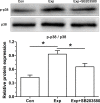Acidic pH promotes nucleus pulposus cell senescence through activating the p38 MAPK pathway
- PMID: 30291218
- PMCID: PMC6239263
- DOI: 10.1042/BSR20181451
Acidic pH promotes nucleus pulposus cell senescence through activating the p38 MAPK pathway
Retraction in
-
Retraction: Acidic pH promotes nucleus pulposus cell senescence through activating the p38 MPAK pathway.Biosci Rep. 2024 Aug 28;44(8):BSR-2018-1451_RET. doi: 10.1042/BSR-2018-1451_RET. Biosci Rep. 2024. PMID: 39171803 Free PMC article. No abstract available.
Abstract
Background: Nucleus pulposus (NP) cell senescence is an important cellular feature within the degenerative disc. It is known that a very acidic niche exists in the degenerative disc, which participates in regulating disc cell viability and matrix metabolism.
Objective: The present study was aimed to investigate the role and potential signaling transduction pathway of an acidic pH in regulating NP cell senescence.
Methods: Rat NP cells were cultured in an acidic pH of 7.2 close to that in a healthy disc (Control group) or in an acidic pH of 6.2 close to that in a severe degenerative disc (Experiment group) for 10 days. Additionally, the experimental NP cells were incubated along with the inhibitor SB203580 to analyze the role of p38 MAPK pathway in this process.
Results: Compared with the control NP cells, experimental NP cells showed a suppressed cell proliferation potency, an increased G0/G1 phase fraction whereas a decreased S-phase fraction and a declined telomerase activity, an up-regulated expression of senescence-related molecules (p16 and p53), and a down-regulated expression of matrix-related moleucles (aggrecan and collagen II). Further analysis showed that inhibition of the p38 MAPK pathway partly reversed effects of acidic pH of 6.2 on the experimental NP cells.
Conclusion: The very acidic niche identified in a severe degenerative disc promotes NP cell senescence through regulating the p38 MAPK pathway. The present study provides a new mechanism that drives NP cell senescence during disc degeneration.
Keywords: intervertebral disc; nucleus pulposus; p38 MAPK; pH; senescence.
© 2018 The Author(s).
Conflict of interest statement
The authors declare that there are no competing interests associated with the manuscript.
Figures






Similar articles
-
Roles of p38 MAPK signalling in intervertebral disc degeneration.Cell Prolif. 2023 Aug;56(8):e13438. doi: 10.1111/cpr.13438. Epub 2023 Mar 5. Cell Prolif. 2023. PMID: 36872558 Free PMC article. Review.
-
Hyper-osmolarity environment-induced oxidative stress injury promotes nucleus pulposus cell senescence in vitro.Biosci Rep. 2019 Sep 20;39(9):BSR20191711. doi: 10.1042/BSR20191711. Print 2019 Sep 30. Biosci Rep. 2019. Retraction in: Biosci Rep. 2024 Aug 28;44(8):BSR-2019-1711_RET. doi: 10.1042/BSR-2019-1711_RET. PMID: 31471533 Free PMC article. Retracted.
-
High-magnitude compression accelerates the premature senescence of nucleus pulposus cells via the p38 MAPK-ROS pathway.Arthritis Res Ther. 2017 Sep 18;19(1):209. doi: 10.1186/s13075-017-1384-z. Arthritis Res Ther. 2017. PMID: 28923094 Free PMC article.
-
Bone morphogenetic protein-7 retards cell subculture-induced senescence of human nucleus pulposus cells through activating the PI3K/Akt pathway.Biosci Rep. 2019 Mar 19;39(3):BSR20182312. doi: 10.1042/BSR20182312. Print 2019 Mar 29. Biosci Rep. 2019. Retraction in: Biosci Rep. 2024 Aug 28;44(8):BSR-2018-2312_RET. doi: 10.1042/BSR-2018-2312_RET. PMID: 30787052 Free PMC article. Retracted.
-
Role of p38-MAPK pathway in the effects of high-magnitude compression on nucleus pulposus cell senescence in a disc perfusion culture.Biosci Rep. 2017 Oct 11;37(5):BSR20170718. doi: 10.1042/BSR20170718. Print 2017 Oct 31. Biosci Rep. 2017. Retraction in: Biosci Rep. 2024 Aug 28;44(8):BSR-2017-0718_RET. doi: 10.1042/BSR-2017-0718_RET. PMID: 28620118 Free PMC article. Retracted.
Cited by
-
Exosomes Derived from Human Urine-Derived Stem Cells Inhibit Intervertebral Disc Degeneration by Ameliorating Endoplasmic Reticulum Stress.Oxid Med Cell Longev. 2020 Dec 7;2020:6697577. doi: 10.1155/2020/6697577. eCollection 2020. Oxid Med Cell Longev. 2020. PMID: 33488928 Free PMC article.
-
Involvement of the G-Protein-Coupled Receptor 4 in the Increased Expression of RANK/RANKL/OPG System and Neurotrophins by Nucleus Pulposus Cells under the Degenerated Intervertebral Disc-Like Acidic Microenvironment.Biomed Res Int. 2020 May 29;2020:1328436. doi: 10.1155/2020/1328436. eCollection 2020. Biomed Res Int. 2020. PMID: 32566653 Free PMC article.
-
Roles of p38 MAPK signalling in intervertebral disc degeneration.Cell Prolif. 2023 Aug;56(8):e13438. doi: 10.1111/cpr.13438. Epub 2023 Mar 5. Cell Prolif. 2023. PMID: 36872558 Free PMC article. Review.
-
IL-1β-mediated inflammatory responses in intervertebral disc degeneration: Mechanisms, signaling pathways, and therapeutic potential.Heliyon. 2023 Sep 7;9(9):e19951. doi: 10.1016/j.heliyon.2023.e19951. eCollection 2023 Sep. Heliyon. 2023. PMID: 37809657 Free PMC article. Review.
-
Exosomes Derived from Bone Marrow Mesenchymal Stem Cells Prevent Acidic pH-Induced Damage in Human Nucleus Pulposus Cells.Med Sci Monit. 2020 May 21;26:e922928. doi: 10.12659/MSM.922928. Med Sci Monit. 2020. PMID: 32436493 Free PMC article.
References
-
- Oegema T.R., Jr (1993) Biochemistry of the intervertebral disc. Clin. Sports Med. 12, 419–439 - PubMed
Publication types
MeSH terms
Substances
LinkOut - more resources
Full Text Sources
Research Materials
Miscellaneous

